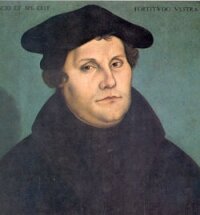
Science (from the Latin scientia, 'knowledge') is a system of acquiring knowledge based on the scientific method, as well as the organized body of knowledge gained through such research. Science as defined here is sometimes termed pure science to differentiate it from applied science, which is the application of scientific research to specific human needs.
The renewal of learning in Europe, that began with 12th century Scholasticism, came to an end about the time of the Black Death, and the initial period of the subsequent Italian Renaissance is sometimes seen as a lull in scientific activity. The Northern Renaissance, on the other hand, showed a decisive shift in focus from Aristoteleian natural philosophy to chemistry and the biological sciences (botany, anatomy, and medicine).
Thus modern science in Europe was resumed in a period of great upheaval: the Protestant Reformation and Catholic Counter-Reformation; the discovery of the Americas by Christopher Columbus; the Fall of Constantinople; but also the re-discovery of Aristotle during the Scholastic period presaged large social and political changes. Thus, a suitable environment was created in which it became possible to question scientific doctrine, in much the same way that Martin Luther and John Calvin questioned religious doctrine. The works of Ptolemy (astronomy), Galen (medicine), and Aristotle (physics) were found not always to match everyday observations. For example, an arrow flying through the air after leaving a bow contradicts Aristotle's laws of motion, which say that a moving object must be constantly under influence of an external force, as the natural state of earthly objects is to be at rest. Work by Vesalius on human cadavers also found problems with the Galenic view of anatomy.
The willingness to question previously held truths and search for new answers resulted in a period of major scientific advancements, now known as the Scientific Revolution. The Scientific Revolution is traditionally held by most historians to have begun in 1543, when De Revolutionibus, by the astronomer Nicolaus Copernicus, was first printed. The thesis of this book was that the Earth moved around the Sun. The period culminated with the publication of the Philosophiae Naturalis Principia Mathematica in 1687 by Isaac Newton.
Other significant scientific advances were made during this time by Galileo Galilei, Edmond Halley, Robert Hooke, Christiaan Huygens, Tycho Brahe, Johannes Kepler, Gottfried Leibniz, and Blaise Pascal. In philosophy, major contributions were made by Francis Bacon, Sir Thomas Browne, René Descartes, and Thomas Hobbes. The scientific method was also better developed as the modern way of thinking emphasized experimentation and reason over traditional considerations.
Approximately 1,000 years ago, modern science began to supplant superstition (the commonly held irrational beliefs emerging from ignorance or fear). What follows is a list of some of the founders of modern science who were, with the exception of one, of the Christian faith. The links below provide information regarding each person's Christian faith and their contributions to humanity.
More...
 Alvin Carl Plantinga (born 15 November 1932 in Ann Arbor, Michigan, USA) is a contemporary American philosopher known for his work in epistemology, metaphysics, and the philosophy of religion and modest support of intelligent design. He is currently the John A. O'Brien Professor of Philosophy at the University of Notre Dame. Despite growing up in the Dutch Reformed tradition, Plantinga along with William Lane Craig, is a prominent proponent of Molinism in the debate over divine sovereignty and providence. He gave the 2004-5 Gifford Lectures at St. Andrews University, titled Science and Religion: Conflict or Concord (to be published).
Alvin Carl Plantinga (born 15 November 1932 in Ann Arbor, Michigan, USA) is a contemporary American philosopher known for his work in epistemology, metaphysics, and the philosophy of religion and modest support of intelligent design. He is currently the John A. O'Brien Professor of Philosophy at the University of Notre Dame. Despite growing up in the Dutch Reformed tradition, Plantinga along with William Lane Craig, is a prominent proponent of Molinism in the debate over divine sovereignty and providence. He gave the 2004-5 Gifford Lectures at St. Andrews University, titled Science and Religion: Conflict or Concord (to be published).






















